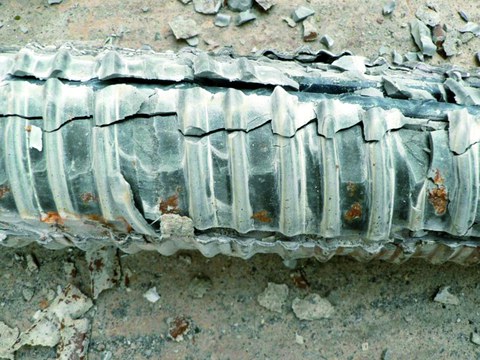Stress Corrosion Cracking in Bridges. Investigation of the bridge stock of Mecklenburg-Vorpommern
Table of contents
Project data
| Titel | Title Spannungsrisskorrosion bei Brücken. Untersuchung des Brückenbestandes in Mecklenburg-Vorpommern | Stress Corrosion Cracking in Bridges. Investigation of the bridge stock of Mecklenburg-Vorpommern Auftraggeber | Client Landesamt für Straßenbau und Verkehr Mecklenburg-Vorpommern Zeitraum | Period 10.2005 – 03.2011 Leiter | Project Manager Dr.-Ing. Torsten Hampel Durchführung | Realisation Dr.-Ing. Thomas Bösche (cbing), Dr.-Ing. Torsten Hampel (TU Dresden), Dr.-Ing. Silke Scheerer (TU Dresden) Projektpartner | Project Partners Landesamt für Straßenbau und Verkehr Mecklenburg-Vorpommern | Curbach Bösche Ingenieurpartner | Saxotest GmbH Dresden | Baustoffprüflabor Neustrelitz |
Report in the yearbook 2009
Stress Corrosion Cracking in Bridges

Selective rust on the outside of the grounting mortar
Since the invention of pre-stressed concrete construction, there has been structural damage from stress corrosion cracking (SCC) from time to time. Hydrogen-SCC is one form of stress corrosion cracking that is typical for pre-stressed components. This only occurs in certain susceptible tendons where there is the simultaneous presence of an electrolyte and tensile stress. This type of corrosion is especially critical, since failure from cracking can occur suddenly and with-out warning due to crack formation. Steels susceptible to this behaviour are no longer produced and have not been produced for many years; however, they are still found in many existing structures. The potential risks have generally been identified in this project along with the development of relative guidelines for dealing with critical structures of this kind.
Approach
Initially, all bridges were subdivided into specific classes or groups of structures based on the SCCgrade criterion. This grade, determined for each bridge, is dependent on the production process and the present condition of the structure. The existence or lack of stress redistribution ability was also taken into consideration during this process. Based on this evaluation, 16 characteristical bridges were analyzed in detail.
The underlying principle of this analytical study is that prestressing steels virtually fail one by one until a specific point in time when the concrete tensile strength is reached under a required load combination at one edge of the beam or component. The (virtual) intact reinforcement is then double checked to determine if it is sufficient for support of the ultimate limit state (of bending). The goal of these static calculations is to verify whether the potential danger of failure of pre-stressed steel reinforcement is indicated by visible cracking (crack-before-failure criterion). A successful static analysis, in this case, does not translate into the actual elimination of a potential SCC danger, but rather, the ability to assess whether or not structural damage can be detected early enough through frequent inspection or to take appropriate strengthening meas-ures to prevent failure.
Findings from the investigation of 16 specific bridges were then applied to the entire bridge stock which were then prioritized according to the need of rehabilitation measures. Sampling took place at selected structures. Currently, additional theoretical investigations of specific static and structural issues for particuluar bridges are underway.
Previous Results
Generally, bridge classification based on SCCgrade was successful as this grade accurately re-flects the realistic level of risk present. In those cases where bridges were identified at high-risk for failure, material investigations were conducted in the short-term to clarify the condition of the structure before strengthening or demolition and replacement were begun. Structures with low risk are inspected more frequently.
